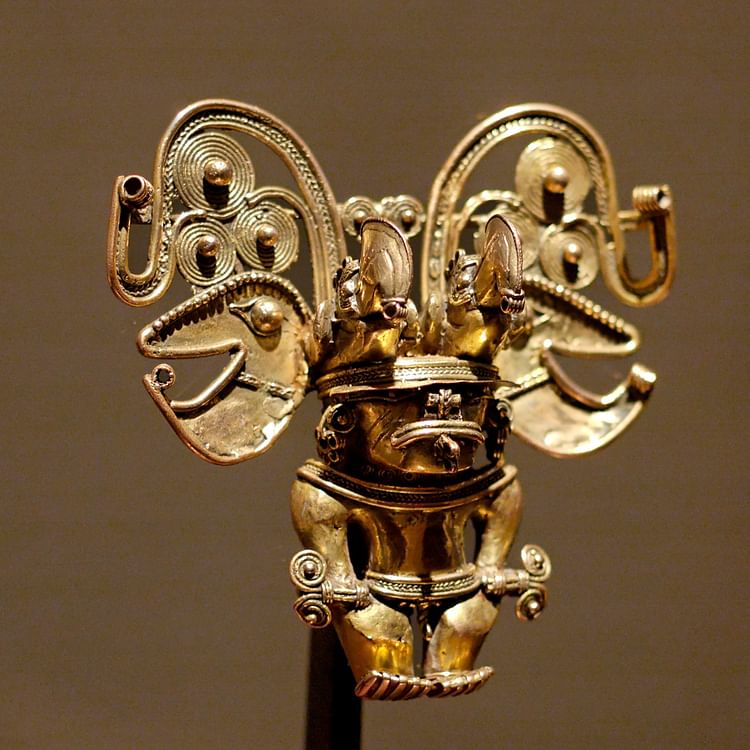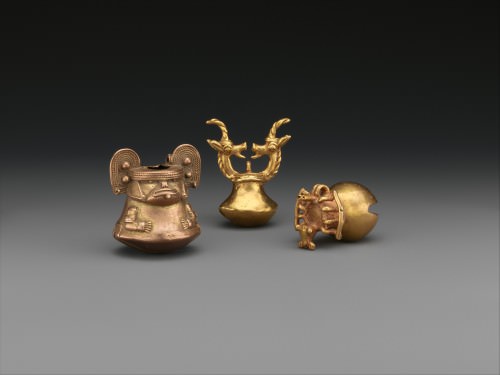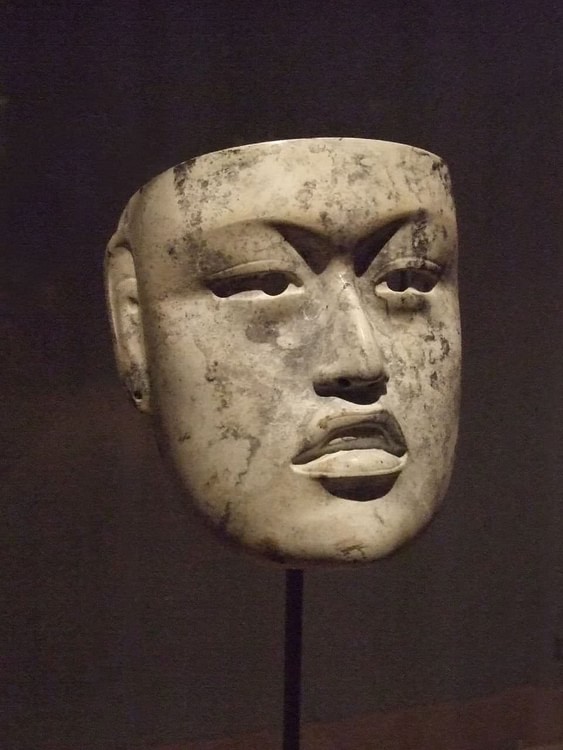Tairona Civilization › Olmec Civilization » Ancient origins
Articles and Definitions › Contents
- Tairona Civilization › Ancient History
- Olmec Civilization › Antique Origins
Ancient civilizations › Historical and archaeological sites
Tairona Civilization › Ancient History
Definition and Origins

The Tairona civilization - one of the Chibcha family tribes - flourished in northern Colombia between 200 CE and 1600 CE.Like the Muisca of Cundinamarca, the Tairona were known for their expertise in crafting and metallurgy, especially goldsmithing. Primarily occupying the Sierra Nevada de Santa Marta region in present-day Magdalena, they left behind them a bountiful of archaeological evidence of their lifestyle, which was surprisingly modern as viewed from the perspective of their relative isolation to more developed civilizations.
HISTORICAL OVERVIEW
The Tairona were as skilled in agriculture as they were in metallurgy. Archaeological findings from as early as 200 CE show that they had the knowledge and expertise of terrace farming, canal building and construction of stone foundations. But that is not what they are renowned for; they are remembered for their exceptional war skills, which made them one of the most difficult tribes to be colonized by the Spanish conquistadores, who had successfully been able to overthrow the Inca, the Aztec, and the Maya empire without much effort. The Tairona ended up fighting with the conquistadores for more than 75 years.
Not surprisingly, many Spaniards became admirers and wrote records about this mysterious, all-powerful tribe that could resist western influence. Many chroniclers recorded the Tairona way of life, their trading systems, their religious beliefs, and their apparent lack of interest in the monetary value of precious metals. So it is not very surprising that the Tairona are believed to be related to the Muisca tribe, as they both shared the same system of power division and a belief in the spiritual significance of gold.
IMPORTANT SITES
The Tairona had to abandon their settlements around mid-17th century CE, and the forests swallowed most of their traces.Still, some remain, a reminder of their remarkable culture.

Pre-Columbian Tribes of Northern South America
One of their most famous settlements was Ciudad Perdida (The Lost City ). Locally known as Teyuna, it was founded around 800 CE, 600 years before Machu Picchu. It is one of the most important pre-Columbian archaeological sites in South America. Accessible by a tiring long trek through thick foliage and some 1,200-odd stone steps, it is believed to have housed anywhere from 2,000 to 8,000 people. Until now, only a part of the once-magnificent city has been properly excavated. The findings have been extraordinary; about 250 mud and stone terraces that served as platforms for houses, spread across 300,000 square meters of densely vegetated land. More recent excavations have also unearthed a number of intriguing objects; ornaments, gold offerings, pottery, and even musical instruments.
Another site, Pueblito, is located near the Carribean coast. According to research, it contains at least 254 terraces and housed a population of about 3,000 people. In the past, there used to be numerous villages and hamlets strewn throughout the valley, forming a large network that would increase trade and other businesses. In fact, the Tairona were even involved in salt production, as found in Chengue, a small fishing village.
SOCIETY
IT WAS THE BELIEF OF THE TAIRONA THAT THE SHAMANS COULD ESCAPE THEIR BODY & GAIN THE KNOWLEDGE OF OTHER CREATURES, WHICH INSPIRED THEIR METALLURGY SUCH AS THE FAMOUS 'BAT MAN' FIGURINE.
The Tairona had a ruling system based on religion. Their rulers were a part of Shaman elite that claimed to be able to control the forces of nature, the cosmos and all human thoughts and actions. One of the chief beliefs of the Tairona people was in the process of transformation. The process is a typical shamanistic power exchange. By cleansing their mind and body, going through long periods of fasting, and exhaustive ritual dances, they believed the shamans' souls could transcend the mortal human condition and acquire knowledge from unknown regions of the cosmos which would be inaccessible to anyone else.Hence the shamans were considered the heads of the tribe and were treated with a great deal of respect, being responsible for gathering armies, controlling agriculture, looking out for the wellbeing of the Tairona, and even supervising the barter trade network. It was the belief of the Tairona that the shamans could escape their body and gain the knowledge of other creatures, which inspired their metallurgy. Most of the ornaments found in their settlements are believed to be of people turning into fierce animals such as the famous 'Bat Man' figurine that depicts a shaman slowly turning into a bat.
RELIGION & ART
Like most tribes thriving in that period, the Tairona's religious beliefs influenced a lot of their artwork and metallurgy. Like the 'Bat Man,' most of their pendants and breastplates boasted of men apparently turning into fearsome creatures, especially birds of prey, crocodiles, and snakes. These ornaments not only represented the status of the person wearing them but also were symbols of the powers he was supposed to be possessing.

Tumbaga Bells of the Tairona Civilization
Transformation was a concept that all tribes of the Chibcha family believed in at that time, and they did their best to implement it. For example, since bats were recognized as one of the most powerful animals then, the Tairona did their best to make themselves look like them. As a result, the costumes that were worn for symbolizing this transformation have been found in the tombs of leading dignitaries of the Tairona period. Researchers at the Banco de la Republica, Colombia, say, "The ornamentation on their metal visors was an allusion to the membranes inside the animal's ear; the cylindrical nose rings raised the nose to make it look like the nostril of certain bat species, and the sub-labial ornaments imitated the fleshiness of the animal's lower lip."
Unlike what most people tend to believe, ancient Colombia was not only a hub for excellent goldwork but also for ceramics.The earliest ceramic objects excavated from the area occupied by the Tairona were dated around 2500 BCE, even though they are believed to have flourished only after 200 CE. Another link to the Muisca seems to be the similarity in goldwork. Both of these Chibcha-speaking tribes had the same variety of offerings for their deities and even had almost the same kind of tunjos.Tunjos are figurines made from tumbaga, which is a mixture of gold, copper, and silver. They generally depict the tribespeople going about their daily life. Another interesting aspect of the modernity of the Tairona is that scholars believe the tribespeople had freedom of divorces. Also, their religious practices were very similar to their present-day counterparts, the Kogui, and went on for days, primarily involving deliberation, coca chewing, and deep meditation.
Olmec Civilization › Antique Origins
Definition and Origins

The mysterious Olmec civilization, located in ancient Mexico, prospered in Pre-Classical (Formative) Mesoamerica from c.1200 BCE to c. 400 BCE and is generally considered the forerunner of all subsequent Mesoamerican cultures including the Maya and Aztecs. With their heartlands in the Gulf of Mexico (now the states of Veracruz and Tabasco), Olmec influence and trade activity spread from 1200 BCE, even reaching as far south as present-day Nicaragua. Monumental sacred complexes, massive stone sculptures, ball games, the drinking of chocolate, and animal gods were all features of Olmec culture which would be passed on to those peoples who followed this first great Mesoamerican civilization.
THE OLMEC ENIGMA
The Olmec civilization presents something of a mystery, indeed, we do not even know what they called themselves, as Olmecwas their Aztec name and meant 'rubber people'. Due to a lack of archaeological evidence their ethnic origins and the location and extent of many of their settlements are not known. The Olmecs did, however, codify and record their gods and religious practices using symbols. The precise significance of this record is much debated but, at the very least, its complexity does suggest some sort of organised religion involving a priesthood. The Olmec religious practices of sacrifice, cave rituals, pilgrimages, offerings, ball-courts, pyramids and a seeming awe of mirrors, was also passed on to all subsequent civilizations in Mesoamerica until the Spanish Conquest in the 16th century CE.
AROUND 900 BCE LA VENTA FLOURISHED AS THE NEW CAPITAL & EVENTUALLY BOASTED A POPULATION OF AROUND 18,000.
OLMEC CITIES
Olmec prosperity was initially based on exploiting the fertile and well-watered coastal areas of the Gulf of Mexico to grow such crops as corn and beans (often twice-yearly) which allowed for an agricultural surplus. They also, no doubt, gathered the plentiful local supply of plant food, palm nuts and sea-life, including turtles and clams. By c. 1200 BCE significant urban centres developed at San Lorenzo (the earliest), La Venta, Laguna de los Cerros, Tres Zapotes and Las Limas. San Lorenzo reached its peak of prosperity and influence between 1200 and 900 BCE when its strategic position safe from flooding allowed it to control local trade. Typical Olmec trade goods included obsidian, jade, serpentine, mica, rubber, pottery, feathers and polished mirrors of ilmenite and magnetite.

Principal Olmec Settlements
Evidence of San Lorenzo's high culture includes the presence of mound structures, possibly an early ball court, carved basalt drains through one of the man-made mounds and the Red Palace structure with painted red floors and workshops. Around 900 BCE the site of San Lorenzo displays evidence of systematic destruction whilst La Venta, conversely, began to flourish, and becoming the new capital, it eventually supported a population of some 18,000.
The three sites of San Lorenzo, La Venta and Laguna de los Cerros all had a bilateral symmetry in their planning and at La Venta the first pyramid in Mesoamerica was constructed. It is the pre-meditated architectural layout of the religious centres of these settlements that is most striking, for example, at La Venta the buildings are placed symmetrically along a north-south axis with four colossal heads facing outwards at key points, seemingly acting as guardians to the complex. A huge ceremonial step pyramid (now a shapeless mound), sunken plaza once lined with 2-metre high basalt columns, and two smaller pyramids/mounds provide features that would be copied time and again at the major sites of later Mesoamerican cultures with whom equal attention was paid to the precise alignment of buildings. La Venta, as with San Lorenzo, suffered systematic and deliberate destruction of its monuments sometime between 400 and 300 BCE.

Olmec Colossal Head
RELIGIOUS BELIEFS
As with other areas of Olmec culture, details of their religion are sketchy. Nevertheless, with an ever-increasing body of archaeological evidence it is possible to piece together some of the most important features of Olmec religion. The Olmecs seem to have had a particular reverence for natural places which connected with the important junctions of sky, earth and the underworld. For example, caves could lead to the underworld and mountains which had both springs and caves could offer access to all three planes. Important Olmec mountain sites were El Manatί, Chalcatzingo and Oxtotitlan.
THE OLMECS ALSO LIKED TO MIX ANIMALS TO CREATE WEIRD & WONDERFUL CREATURES SUCH AS THE WERE-JAGUAR, A CROSS BETWEEN A HUMAN & A JAGUAR.
The names of the gods of the Olmec are not known other than that they often represented phenomena such as rain, the earth and especially maize. For this reason, identifiable gods from Olmec art have been given numbers instead of names (eg God VI). The Olmecs gave special significance to the animals present in their environment, especially those at the top of the food chain such as jaguars, eagles, caimans, snakes and even sharks, identifying them with divine beings and perhaps also believing that powerful rulers could transform themselves at will into such fearsome creatures. The Olmecs also liked to mix animals to create weird and wonderful creatures such as the were-jaguar, a cross between a human and a jaguar, which may have been their supreme deity. We also know that they worshipped a sky-dragon and that they believed four dwarves held up the sky, possibly representing the four cardinal directions which, along with other Olmec gods, became so important in later Mesoamerican religions.
OLMEC ART
The most striking legacy of the Olmec civilization must be the colossal stone heads they produced. These were carved in basalt and all display unique facial features so that they may be considered portraits of actual rulers. The heads can be nearly 3 m high and 8 tons in weight and the stone from which they were worked was, in some cases, transported 80 km or more, presumably using huge balsa river rafts. 17 have been discovered, 10 of which are from San Lorenzo. The ruler often wears a protective helmet (from war or the ballgame) and sometimes show the subject with jaguar paws hanging over the forehead, perhaps representing a jaguar pelt worn as a symbol of political and religious power. The fact that these giant sculptures depict only the head may be explained by the belief in Mesoamerican culture that it was the head alone which bore the soul.

Olmec Stone Mask
Another permanent record of the Olmecs is found in rock carvings and paintings. Often made around cave entrances they most typically depict seated rulers, as for example at Oxtotitlan, where a figure wears a green bird suit and at Chalcatzingo where another ruler sits on her throne surrounded by a maize landscape. At other sites there are also paintings of cave rituals, for example, at Cacahuazqui, Juxtlahuaca and Oxtotlan.
INTRIGUINGLY, THE OLMECS OFTEN BURIED THEIR SCULPTURES, EVEN LARGER PIECES, PERHAPS IN A RITUAL ACT OF MEMORY.
Jade and ceramic were other popular materials for sculpture and also wood, some examples of which were remarkably well preserved in the bogs of El Manati. One of the gods most commonly rendered in small sculpture was God IV, sometimes called the Rain Baby, who is a toothless human baby with an open-mouth, cleft head and headband, sometimes with the addition of strips of crinkled paper hanging at the side of his face (another feature seen in the gods of later cultures and representing the paper and rubber sap strips which were burnt during rites as the smoke was thought to propitiate rain).
Perhaps the most significant jade carving is the Kunz Axe, a ceremonial axe-head now in the American Museum of Natural History in New York. The jade has been worked to represent a were-jaguar creature using only jade tools and then polished, perhaps using a jade abrasive. Animals were a popular subject, especially those most powerful ones such as jaguars and eagles. Intriguingly, the Olmecs often buried their sculptures, even larger pieces, perhaps in a ritual act of memory.
LEGACY IN MESOAMERICA
The Olmecs influenced the civilizations they came into contact with across Mesoamerica, particularly in sculpture in ceramic and jade and objects featuring Olmec imagery have been found at Teopantecuanitlan, 650 km distant from the Olmec heartland. In addition, many deities featured in Olmec art and religion such as the sky-dragon (a sort of caiman creature with flaming eyebrows) and the feathered-snake god, would reappear in similar form in later religions. The snake-god especially, would be transformed into the major gods Kukulcan for the Maya and Quetzalcoatl for the Aztecs. This artistic and religious influence, along with the features of precisely aligned ceremonial precincts, monumental pyramids, sacrificial rituals and ball-courts, meant that all subsequent Mesoamerican cultures would owe a great deal to their mysterious forerunners, the Olmecs.
LICENSE:
Article based on information obtained from these sources:with permission from the Website Ancient History Encyclopedia
Content is available under License Creative Commons: Attribution-NonCommercial-ShareAlike 3.0 Unported. CC-BY-NC-SA License